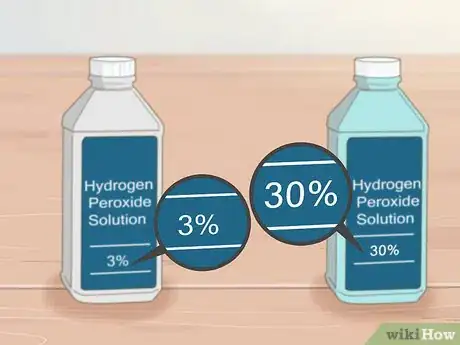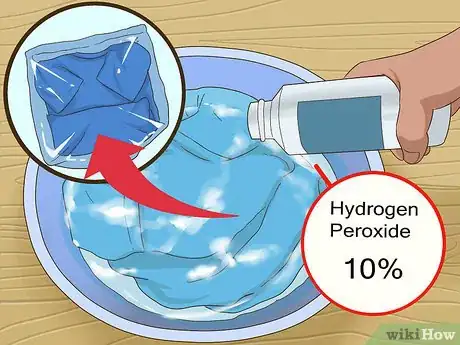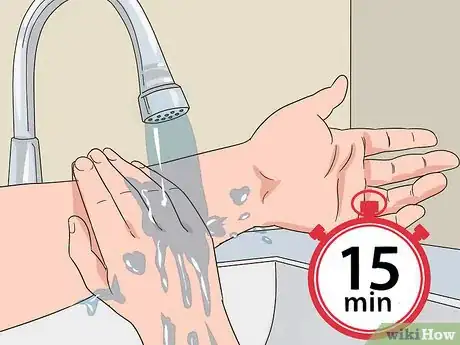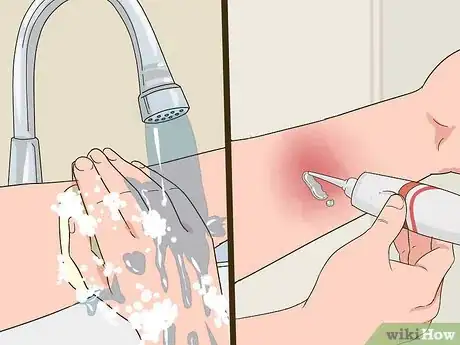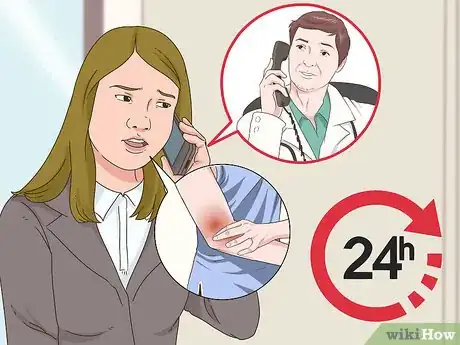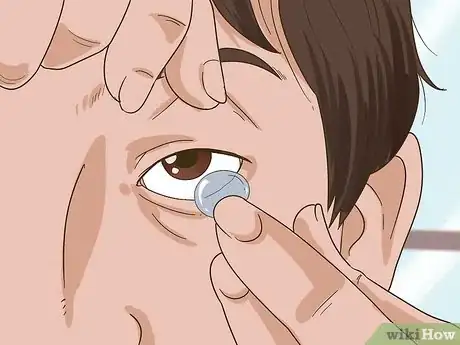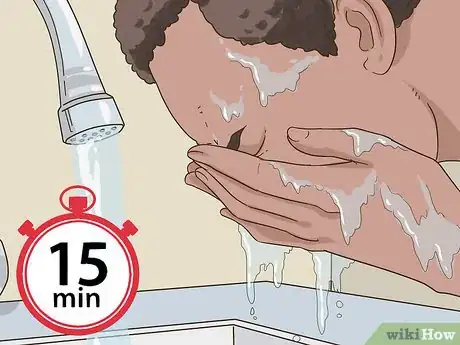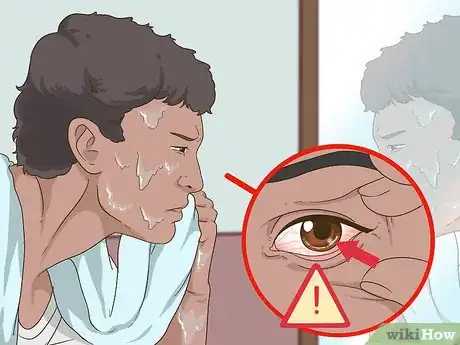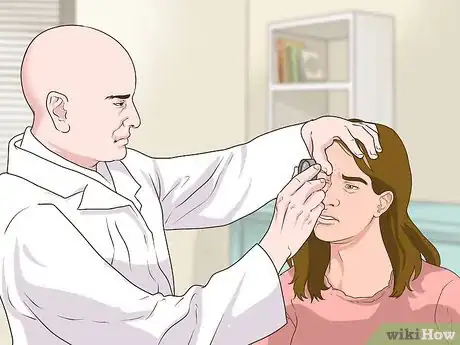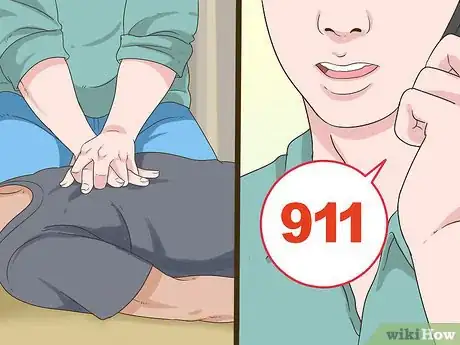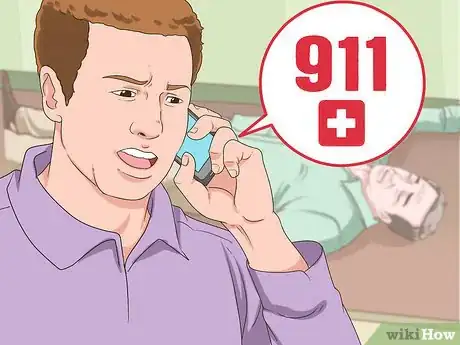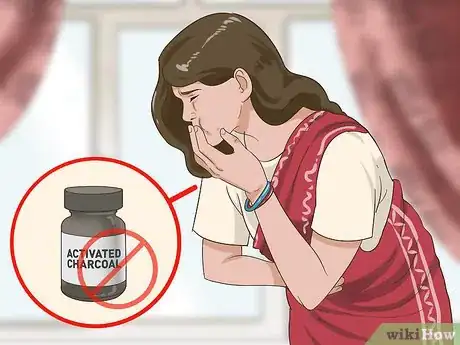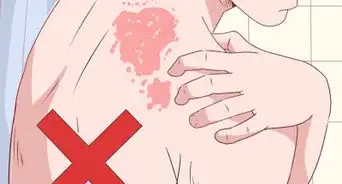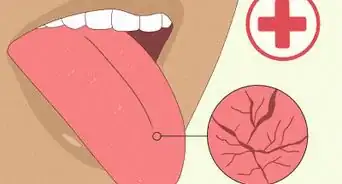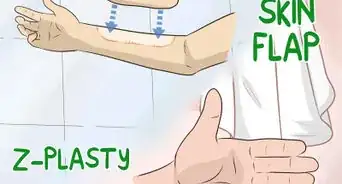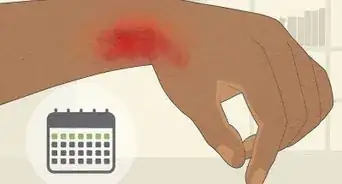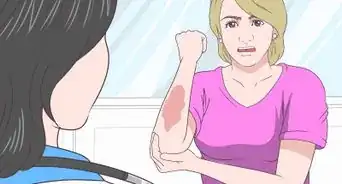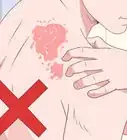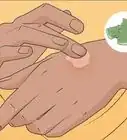This article was medically reviewed by Mohiba Tareen, MD. Mohiba Tareen is a board certified Dermatologist and the founder of Tareen Dermatology located in Roseville, Maplewood and Faribault, Minnesota. Dr. Tareen completed medical school at the University of Michigan in Ann Arbor, where she was inducted into the prestigious Alpha Omega Alpha honor society. While a dermatology resident at Columbia University in New York City, she won the Conrad Stritzler award of the New York Dermatologic Society and was published in The New England Journal of Medicine. Dr. Tareen then completed a procedural fellowship which focused on dermatologic surgery, laser, and cosmetic dermatology.
This article has been viewed 202,325 times.
Hydrogen peroxide is a common household cleaner that can cause skin, eye, and digestive irritation. Fortunately, household solutions contain a low concentration of hydrogen peroxide. Most cases of irritations or burns from these solutions can be easily treated by flushing the affected area with cool water. Cases involving solutions with higher concentrations will likely require emergency medical assistance, but rarely result in severe or long-term injuries.
Steps
Treating Skin Burns
-
1Determine the product’s concentration of hydrogen peroxide. Knowing the strength of the hydrogen peroxide solution will help you decide the best course of treatment, whether the burn affects the skin, eye, or digestive system. The container’s label will note its contents’ concentration.[1]
- Most household hydrogen peroxide solutions are about 3% hydrogen peroxide and 97% water. These can cause minor irritation to the skin, eyes, or digestive system, stinging, and/or whitening of the skin, but can almost always be treated by simply flushing the area with cool water.
- Products that bleach hair can contain between 6 and 10% hydrogen peroxide, and can be more harmful than standard household solutions.
- Industrial solutions contain between 35 and 90% hydrogen peroxide. These can cause chemical burns that require immediate emergency care. You may notice blistering on the skin. Call emergency services immediately to treat exposures to industrial hydrogen peroxide.
-
2Remove any clothing soaked with hydrogen peroxide. Free the burned or irritated area from contaminated clothing as soon as possible, especially when exposed to higher concentrations. Take off any clothes, jewelry, or other accessories that might have been splashed or soaked. Place the clothing in plastic bags if the concentration of hydrogen peroxide is 10% or higher.Advertisement
-
3Flush the area with cool water for at least 15 minutes. Hold the affected area under cool running water to rinse away the solution and ease pain. Flushing under a faucet will effectively treat small patches of skin exposed to household concentrations. Take a cool shower to flush larger patches of contaminated skin or areas exposed to a higher concentration.
- If you can't flush the area, try holding a cool compress against your skin to relieve the pain.[2]
-
4Wash the area gently and apply an ointment or gel. Chemical burns that result from hydrogen peroxide exposure can be treated like thermal burns. Continue to flush with cool water until pain starts to subside, use a mild soap to gently wash the area, and apply an antibacterial ointment.[3]
- Avoid scrubbing or breaking any small blisters that develop.
- Consider applying an aloe vera gel to ease discomfort.[4]
-
5Contact a doctor if you experience unusual symptoms within 24 hours. Within a day of exposure, look for signs including worsening redness, irritation, and pus or discharge from the burn. Seek a follow-up examination if you experience any of these symptoms.
- Schedule an appointment with your primary care doctor, contact the medical professional who treated your wound, or visit a local clinic for a follow-up examination.
Dealing with Eye Irritation
-
1Remove your contact lenses. If you wear contact lenses and can easily remove them, do so immediately. Once they’re out, begin flushing your eyes. If you have trouble taking your lenses out, get help from someone you trust nearby or a responding medical professional.
-
2Flush your eyes with cool water for at least 15 minutes. Rinse your hands well to ensure they’re free of hydrogen peroxide solution. Cup them under running cool water and continuously flush your eyes for 15 to 20 minutes. Try taking a cool shower to flush your eyes if you have difficulty doing so with a faucet and sink.
- You can also try flushing your eyes with a .9 % saline solution. If you have a bottle of saline solution on hand, check its label to find out its concentration.[5]
-
3Test your vision and look for corneal damage. Once your eyes have recovered from the water or saline flush your eyes, make sure your vision isn’t impaired in any way. Seek medical attention if you experience any unusual blurriness or obstructions in your visual field. Have someone check your eyes for surface abrasions or deformities, and seek emergency care if you show these or any other signs of damage.
-
4Consult a doctor immediately. If your eyes were exposed to hydrogen peroxide at any concentration, you should see a doctor as soon as possible.[6] If you were exposed to a higher concentration of hydrogen peroxide, you should contact emergency services immediately as it can rapidly cause cornea burns. If you experience changes in your vision or have signs of abrasion or damage, have someone take you to an emergency room. Follow up with an appointment with your ophthalmologist, or eye doctor, if you have one.
Treating Oral or Internal Exposure
-
1Ensure the victim is breathing and has a pulse. Ingesting a large amount or high concentration of hydrogen peroxide can cause difficulty breathing. If a victim loses consciousness and exhibits shallow breathing, a weak pulse, or no breathing or pulse, you (or someone CPR certified) should administer CPR and call emergency services immediately.
- Even if the victim can breathe and CPR isn’t required, emergency personnel may still offer a respiratory mask to someone who’s ingested hydrogen peroxide, especially at higher concentrations.
-
2Call emergency services. You’ll require emergency assistance if the victim has ingested large amounts of household hydrogen peroxide or a high concentration solution. You can call emergency services or your local poison control center. If you live in the United States, call poison control at 1-800-222-1222.[7]
- Be prepared to describe the victim’s age, weight, and condition. Tell the emergency operator the name of the product ingested and solution strength. Let them know the time and amount that they swallowed.
-
3Drink a glass of water or milk. Drinking 4 to 8 ounces (120 to 240 mL) of water or milk may effectively treat ingestion of a small amount of household hydrogen peroxide. For cases involving larger amounts or higher concentrations, you should still drink water or milk, but be sure to contact emergency services as soon as possible.
- Try gargling repeatedly with cool water if your mouth is the only affected area.
-
4Avoid inducing vomiting or using activated charcoal. While hydrogen peroxide can cause vomiting, you should not induce it if the victim is not vomiting already. You should also avoid using activated charcoal, as it will have no effect on ingested hydrogen peroxide.[8]
- If your case is severe enough for hospitalization, medical professionals will administer an endoscopy to examine your digestive tract. Activated charcoal will interfere with this examination.
Expert Q&A
-
QuestionDoes aloe really help burns?
 Mohiba Tareen, MDMohiba Tareen is a board certified Dermatologist and the founder of Tareen Dermatology located in Roseville, Maplewood and Faribault, Minnesota. Dr. Tareen completed medical school at the University of Michigan in Ann Arbor, where she was inducted into the prestigious Alpha Omega Alpha honor society. While a dermatology resident at Columbia University in New York City, she won the Conrad Stritzler award of the New York Dermatologic Society and was published in The New England Journal of Medicine. Dr. Tareen then completed a procedural fellowship which focused on dermatologic surgery, laser, and cosmetic dermatology.
Mohiba Tareen, MDMohiba Tareen is a board certified Dermatologist and the founder of Tareen Dermatology located in Roseville, Maplewood and Faribault, Minnesota. Dr. Tareen completed medical school at the University of Michigan in Ann Arbor, where she was inducted into the prestigious Alpha Omega Alpha honor society. While a dermatology resident at Columbia University in New York City, she won the Conrad Stritzler award of the New York Dermatologic Society and was published in The New England Journal of Medicine. Dr. Tareen then completed a procedural fellowship which focused on dermatologic surgery, laser, and cosmetic dermatology.
FAAD Board Certified Dermatologist Yes! Pure aloe vera gel can ease discomfort and help your burn heal faster.
Yes! Pure aloe vera gel can ease discomfort and help your burn heal faster.
References
- ↑ https://medlineplus.gov/ency/article/002652.htm
- ↑ Mohiba Tareen, MD. FAAD Board Certified Dermatologist. Expert Interview. 26 March 2020.
- ↑ http://www.mayoclinic.org/first-aid/first-aid-burns/basics/art-20056649
- ↑ Mohiba Tareen, MD. FAAD Board Certified Dermatologist. Expert Interview. 26 March 2020.
- ↑ https://toxnet.nlm.nih.gov/cgi-bin/sis/search2/r?dbs+hsdb:@term+@rn+@rel+7722-84-1
- ↑ http://www.h2o2.com/technical-library/default.aspx?pid=66&name=Safety-amp-Handling
- ↑ https://medlineplus.gov/ency/article/002652.htm
- ↑ https://toxnet.nlm.nih.gov/cgi-bin/sis/search2/r?dbs+hsdb:@term+@rn+@rel+7722-84-1
About This Article
To treat a hydrogen peroxide burn on your skin, try washing the affected area with cold water to reduce irritation. If you’ve been exposed to a household product, run the burn under a faucet for 15 minutes. However, if you’ve been exposed to higher concentrations of hydrogen peroxide, like hair bleaching products, take a cold shower. Then, wash the area with a mild soap and apply an anti-bacterial ointment to prevent infection. If you experience unusual symptoms within 24 hours, like redness or leaking puss, contact a doctor immediately. Remember that industrial products containing hydrogen peroxide can cause severe burns. If you’ve been exposed to an industrial grade of hydrogen peroxide, seek medical attention straight away. For tips from our Medical co-author on how to treat eye burns from hydrogen peroxide, keep reading!
